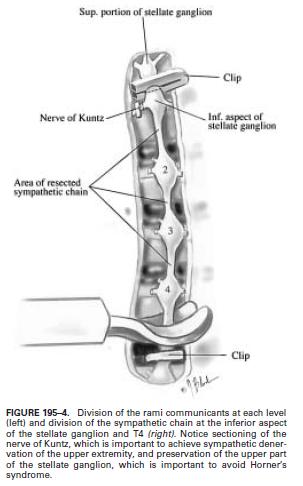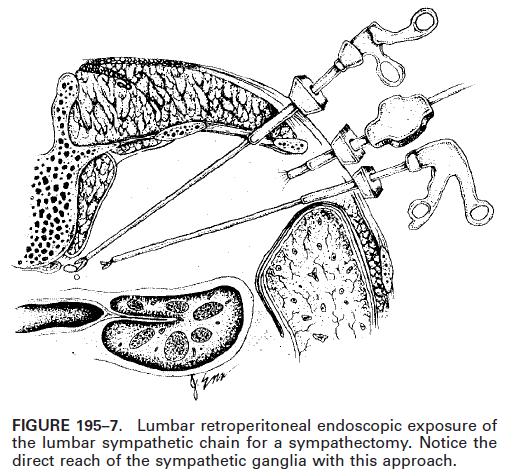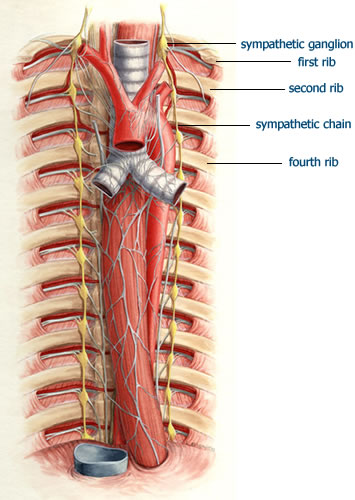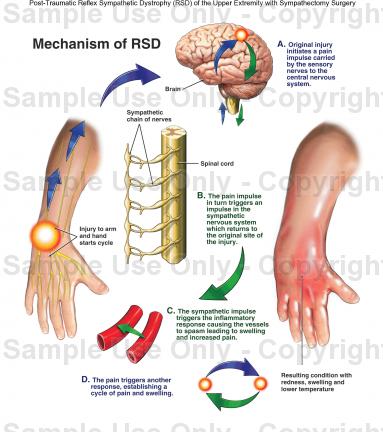 |
 ความคิดเห็นที่ 23
ความคิดเห็นที่ 23 |

HISTORY
Claude Bernard and Brown Sequard described the physiology of the sympathetic nervous system in 1852. Bernard showed that the removal of the stellate ganglia in rabbits led to an increased temperature in that side of the animals face, contrary to his own theory that the temperature should decrease. Gaskell and Langley
mapped the sympathetic ganglia distribution, although in a rudimentary fashion, in 1859. The true segmental distribution of the sympathetic nervous system became available only much later.4 When surgeons became aware of the anatomic distribution and physiologic consequences of this curious system, their creative
minds found numerous reasons to surgically intervene in the sympathetic nervous system.8 In 1889, Alexander performed the first cervical sympathectomy for the treatment of epilepsy.
The resuthe results of several other surgical interventions in
the sympathetic system. Jaboulay and Jonnesco tried stellectomy for treatment of exophthalmic goiter in 1896. Other applications with marginal results were described in the late 1800s and early 1900s, including glaucoma in 1889, trigeminal neuralgia in 1902, optical nerve atrophy in 1905, and angioma of the external
carotid artery in 1917.
Leriche, the famous French vascular surgeon, dedicated
his research to the enervation of large arteries such as the femoral and axillary arteries. He was interested in surgical procedures to improve peripheral vascular insufficiency. He was a student of Jaboulay, who in the late 1800s described the stripping of large arteries from their nerve supply to improve distal circulation.
Leriche found that sympathectomy was a more effective procedure than artery denervation.Vascular surgeons treating peripheral vascular insufficiency largely used this procedure. Two Australian scientists, Royle and Hunter, believed that sympathectomy improved spasticity. They thought that sympathetic fibers
maintained skeletal muscle tonus.
Their work became widely know, but their results could not be reproduced. The interest on the physiology of the sympathetic
nervous system was greatly enhanced by the theory of Royle and Hunter. The clinical observations of Royle and Hunter were important to support the vascular effects of sympathectomy.
Similar to the operation of Royle and Hunter, another application of sympathectomy that fell into disuse was for the treatment of arterial hypertension by resection of the splanchnic plexus.
Sympathectomy was settled as a treatment of peripheral vascular disease.
In 1925, Adson and Brown described the posterior approach for removal of the second thoracic sympathetic ganglion. Davis and Kanavel reported the anterior approach to the upper thoracic sympathetic chain in the same year.
Atkins developed the transaxillary approach in 1954.
After 1920, sympathectomy also gained acceptance for treatment of hyperhidrosis through the work of Kotzareff. Cloward16 described the dorsal midline approach to both sides of the sympathetic chain in 1969, and the approach gained popularity
among neurosurgeons.
After Wilkinson described the fluoroscopic approach to the thoraciclt was marginal, as were sympathetic chain, Adler and coworkers described the computed tomography (CT)guided approach. Chuang and colleagues described a stereotactic approach to the upper thoracic ganglia for treating hyperhidrosis.
In 1928, Spurling resected the stellate and first thoracic ganglion for the treatment of causalgia of theupper extremity resulting from a partial lesion of the axillary artery by a gunshot wound. He hypothesized that vascular insufficiency of the arm led to the pain
and that posterior sympathectomy as described by Adson
and Brown improved the circulation and pain.
Since then, the treatment of causalgia and sympathetic dystrophy with sympathectomy has been encouraging.
Rates of 59% to 74% for excellent results and of 9% to 17% for fair control of pain have appeared in the literature.
The term causalgia was derived from two Greek words, kausos, meaning heat, and algos, meaning pain.
The term describing burning pain was coined from the work of Weir Mitchell because of his detailed description of the syndrome after major nerve injuries identified during the United States Civil War, although Pare probably described the first case of causalgia in
the 16th century.
http://www.neurosurgerytext.com/storedfiles/chapter195.pdf?CFID=2489781&CFTOKEN=83432234
| จากคุณ |
:
กิ๊ฟไม่ใช่ตุ๊กตา   
|
| เขียนเมื่อ |
:
วันวิสาขบูชา 53 13:33:14
|
|
|
|
 |











 งงเป่า
งงเป่า